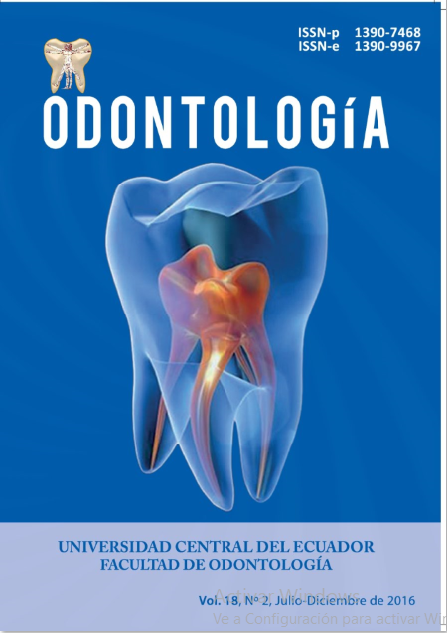Micro-hardness of permanent teeth with incipient fluorosis treated with infiltrant resin
Keywords:
Microhardness, dental fluorosis, IconAbstract
Objective: To evaluate the microhardness of the enamel affected by fluorosis subjected to treatment with infiltrating resin, comparing it with sound teeth and teeth with incipient fluorosis. Materials and methods: The sample consisted of 15 permanent human teeth collected from the Teeth Bank of the Faculty of Odontology of the Central University of Ecuador. For the selection of the teeth, diagnostic criteria of dental fluorosis were considered according to Thylstrup and Ferjeskov (1978), having 5 teeth with score 0 and 10 teeth with incipient fluorosis (score 1-3). None of the teeth that were examined in the study had caries, cracks or fractures. The sample was divided into 3 groups. G1: sound teeth (negative control), G2: teeth with incipient fluorosis and G3: teeth with incipient fluorosis treated with Icon® infiltrating resin. To each group (n=5), dental prophylaxis was performed and afterwards to G3, infiltrating resin was applied. The Knoop micro-hard-ness was obtained through 3 indentations with microhardness tester (Wilson Tukon Microhardness Tester). The data were analyzed through the Spearman’s Rho method with 5% significance. Results: The median of Knoop microhardness of the groups and their standard deviations were: G1=284.8 ± 56.2 G2=325.7 ± 95.1 G3=226.2 ± 67.4, no statistically significant differences were found between the examined groups (p>0.05). Conclusion: The microhardness of the enamel affected by incipient fluorosis subjected to treatment with infiltrating resin, enamel of sound teeth, and enamel of teeth with incipient fluorosis did not demonstrate statistical difference.


